Maybe one day my bog garden will look as good, although on a much smaller scale, as the one we visited the other day at Marwood Hill Garden. The garden covers 20 acres altogether and contains 3 lakes with streamside planting set in a north Devon valley along with herbacious borders and a large rock garden.
The gardens were started in the 1950s by the late Dr. Jimmy Smart VMH. The Victoria Medal of Honour is awarded by the RHS to those who make an outstanding contribution to horticulture. I remember him zooming round on his buggy when we last visited. Dr. Smart died in 2002 and the garden is now owned and maintained by his nephew and a band of volunteers working with a head gardener.
The large bog garden beside the lakes and streams provides just the right conditions for moisture loving plants and they hold the National Collection of Astilbes, Iris Ensata and Tulbaghia. This was the obvious place to come, when I decided that I needed another Astilbe for my much smaller bog garden and we were lucky in that the primulas were still flowering and the astilbes had just started.
There are a few sculptures in the garden, including these realistic geese in the stream.
A very tranquil area way down the valley, a grove of birch trees.
Beyond the birch trees, more stunning planting with Primula viallii in the foreground and toning candelabra primulas in the background. Viallii start out with their poker flowers all red when in bud, but change to mauve when the flowers open. All this planting was very new indeed when we last visited, lovely to see how it has all come together like a tapestry.
A lovely little bridge to take us over to the other side of the stream to wend our way back with a beautiful planting of astilbes.
Lots of wild foxgloves on all the banks further away from the water.
A collection of various Eucalyptus planted up the hill away from the stream. 10 yrs ago, these trees were so tiny, barely 6ft tall, what a difference!
A statue of the late Dr. Jimmy Smart, enjoying the view down the valley with his beautiful streamside planting.
Large groups of rodgersias accompany the primulas.
More sculpture on the island in the centre of the upper lake. Lots of ducks and moorhens were on the island and yes, it was still raining!
The early astilbes have started flowering. This area will look fantastic in a couple of weeks when they are all flowering at once.
And even more primulas, some of them have grown so tall with all our extra rain. On the right is a pink ensata iris, very pretty.
There were large clumps of white rosebay willow herb, Epilobium angustifolium f. album, which looked very healthy. We have a very pathetic few plants here that wander around each year, never coming up in the same place twice. These were planted at the side of the stream, I never realised that they like moist soil, they are obviously looking for our underground stream, must move them to the back of the boggy border!
And even more primulas! The tall yellow ones must be P. sikkimensis I think or maybe P. florindae.
A super planting of large hostas at the head of the first lake, no slug damage here, but further down by the stream, they certainly had a problem.
A last look at primulas before making our way round to the walled garden where the nursery is. You didn’t really think I would leave without buying something did you? One white Iris ensata, one astilbe and one candelabra primula just like the one in the foreground, which I was told would seed itself about, coming up in all the colours of the rainbow! It was lovely seeing the primulas and astilbe in such numbers, I just had to remember that their bog garden is about 20 times the size of our whole garden, but maybe one day, I will have our border bursting at the seams with colourful primulas and astilbes, just like theirs.

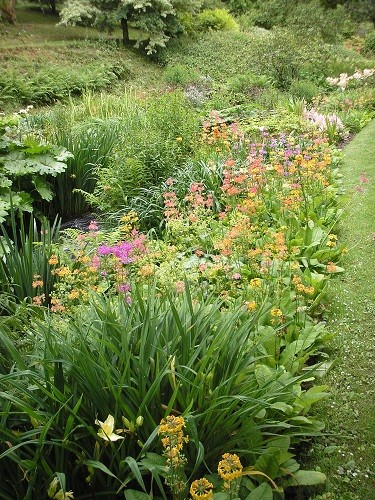

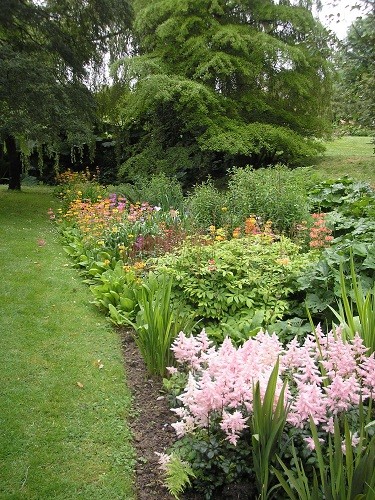



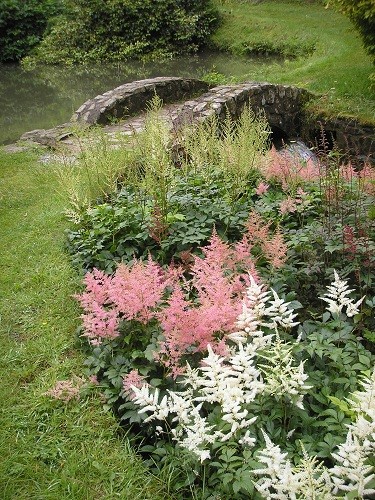







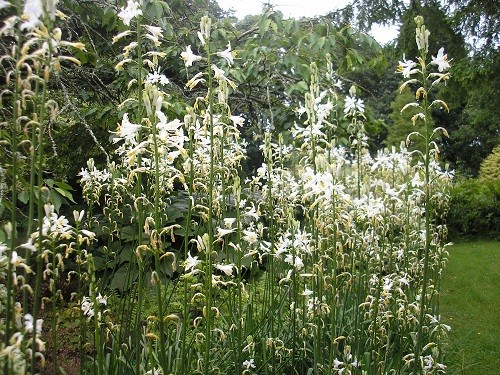
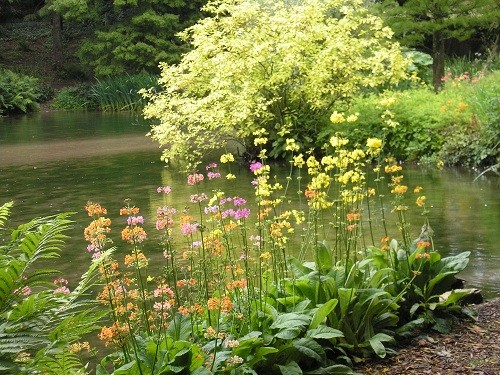
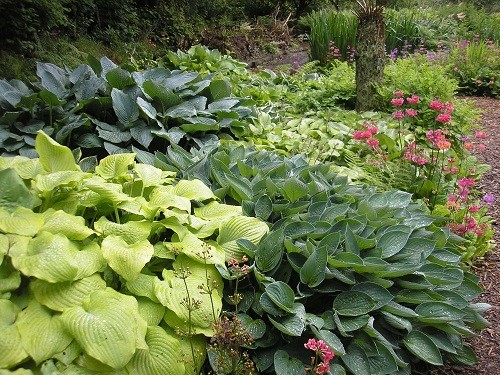

thanks Pauline for a lovely virtual visit, that tree growth in 10 years when I compare with the little growth on mine in 10 years, such inspiration for you and a nursery to for buying plants, the sculptures look beautiful too and another interest of yours, I like the way the white trunks of the birches are echoed in the pillars on the pavillion, Frances
The trees probably grow so well Frances, because they are in a sheltered valley with plenty of rain water. I think there is something beautiful about a grove of silver birch trees, their bark is so tactile and that little area was so peaceful. Its a lovely garden to visit at any time of year, mustn’t leave it 10yrs until our next visit!
love the picture with the road winding away into the distance.
Lots of interesting paths Diana, to lead you into different parts of the garden. I imagine this is what good design does, makes you want to explore further.
So beautiful! I have always loved primulas, but there is no hope for them in my garden conditions. Thanks for the tour!
This is the bonus Deb of all our rain!! They are such a diverse family, some like it rocky , in the sun, others, like these need lots of moisture and can take quite a bit of shade.and a lovely perfume too.
Simply stunning. I can just imagine all the astibles in full force. And the primulas and more and more a just gorgeous. Thanks, so much.
Lovely to hear from you Patrick, I seem to recall that you knew and loved them in Australia? They are a wonderful family of plants, and come in such amazing colours.
While all the plantings are lovely, I especially love the combo of the primula viallii and the colour matched candelabra. A combo I hope to copy at KG one day.
They do look good together don’t they Deborah, and would even have looked good when the viallii were in bud. I thought the little waterfall in the background made all the difference, a bit of white to lighten it all.
What a beautiful garden – one I was, embarrassingly, unaware of – right up my street. Those candelabra primulas are perfect – absolutely beautiful… Sigh. Thanks for the tour!
It is a beautiful garden Kate and one that can be visited at any time of year, there is so much going on in different areas. They now provide tea, coffe and lunches so you can spend all day there and still not see it all!
I’m so happy garden bloggers are sharing their garden visits. There are very few gardens worth visiting here, exceppt for the Renaissance ones. It is something I miss. thank you. I have been to Marwood but must confess I only have a very vague memory, it was a long time ago. Christina
I agree Christina, I’m enjoying revisiting gardens when people do a post about them and see how they have developed, they bring back happy memories. Others inspire so much that they get put on the “to do” list, hopefully to be visited in the future.
You make me feel like growing some primulas… P. viallii has always been one of my faves. I need to get rid of these mad ideas though, primulas wouldn’t survive one week in my garden! The place you visited looks very interesting and inspiring, especially for you. I think your bog garden and the rainbow border already look very good, no need to envy anyone.
I like those geese, they look realistic, but kind of made of ash, as if someone shooted them with a firegun!
You’re so right Alberto, primulas wouldn’t last very long in your heat, we will just have to admire each others gardens from afar! The garden was very inspirational for me, I tend to visit the parts of a garden first that I can relate to, then visit the rest if I have plenty of time. Loved your comment about the geese, I think all the sculptures were made from some kind of resin.
Hello Pauline, I think you’ll find the tall yellow primula you mention is p.prolifera, which is the most commonly-seen yellow candelabra. p.sikkimensis & p.florindae have drooping bell flowers, so it’s not those. For some reason, p.prolifera never does very well with me, but you should try it, certainly. I’ve had a lot of trouble with astilbes which happily interbreed and seed themselves, inevitably producing shocking pink flowers – which aren’t what I want at all!
Thanks Kininvie for sorting out which primula the yellow one is, there are so many different varieties aren’t there! Can imagine you not wanting shocking pink astilbes, some of the colours are a bit strident!!
Pauline, if you are going to get into primulas in a big way, find someone to give you John Richards’ ‘Primula’ for Christmas. For a botanical reference book it’s surprisingly readable, and beautifully illustrated too. You can always cross-check species on Pam Eveleigh’s Primula World site. Non-specialist nurseries, I find, are remarkably casual about getting the right name for their primulas…
Thanks for coming back Kininvie, the book ” Primula” by John Richards sounds really good, will certainly put it on the Christmas list, but will I be able to wait that long ?! I’ve also made a note of Pam Eveleigh’s site and know I will enjoy exploring it. I don’t know about getting into primulas in a big way, I’m limited by the length of the bog garden, but I find them such an interesting species.
Hi, the sculptures are of Swans, not Geese! I made this sculpturte in 2009, in wax, and cast it in bronze. Glad you liked them, Johnny Cox
Hi Johnnie, lovely to hear from you! Being a woodcarver, I am very partial to sculpture in the garden and really liked your lifelike swans. Having a few of my carvings in the garden here, I am always trying to encourage other gardeners to think beyond just plants and create focal points. Nice to hear from you, thanks for leaving your message.